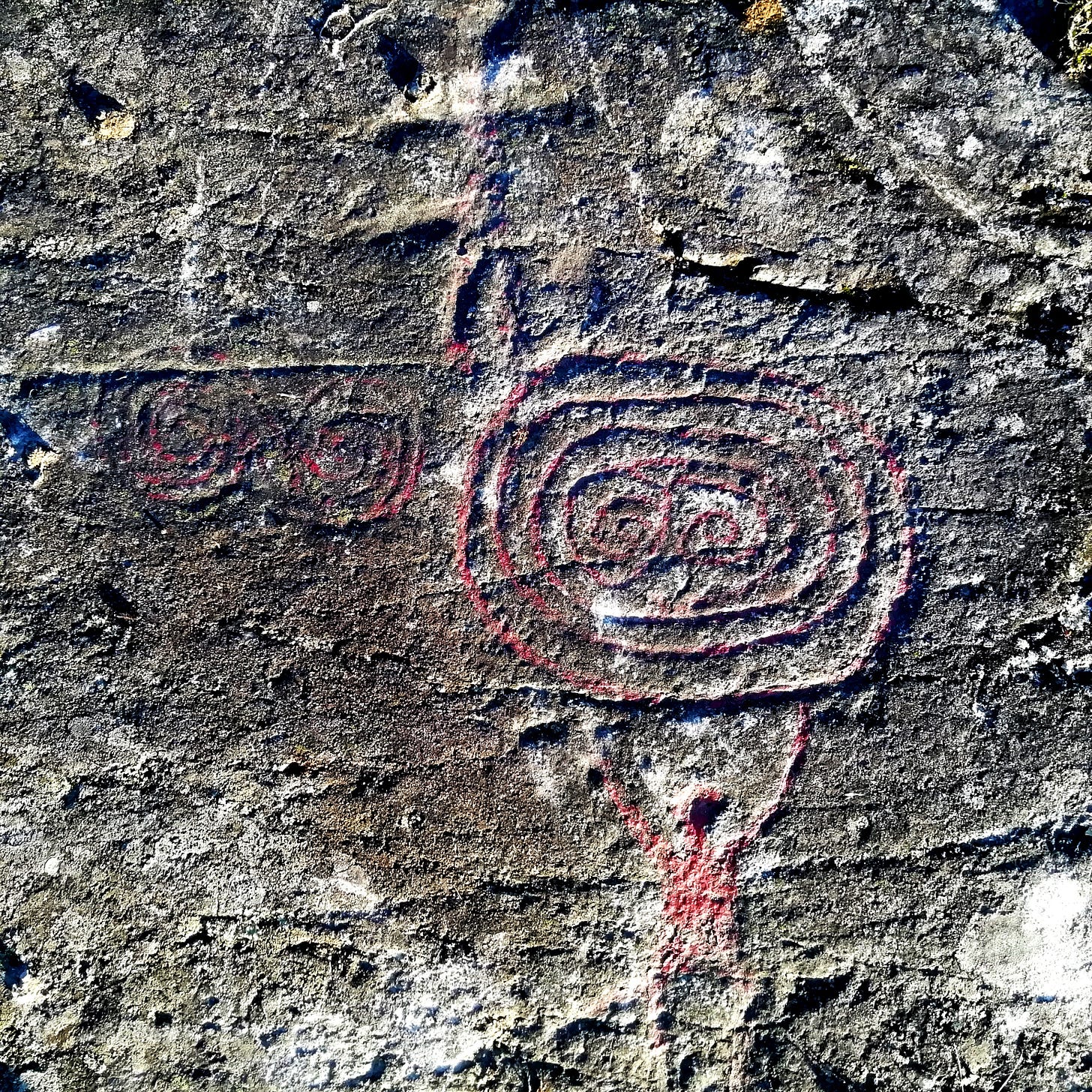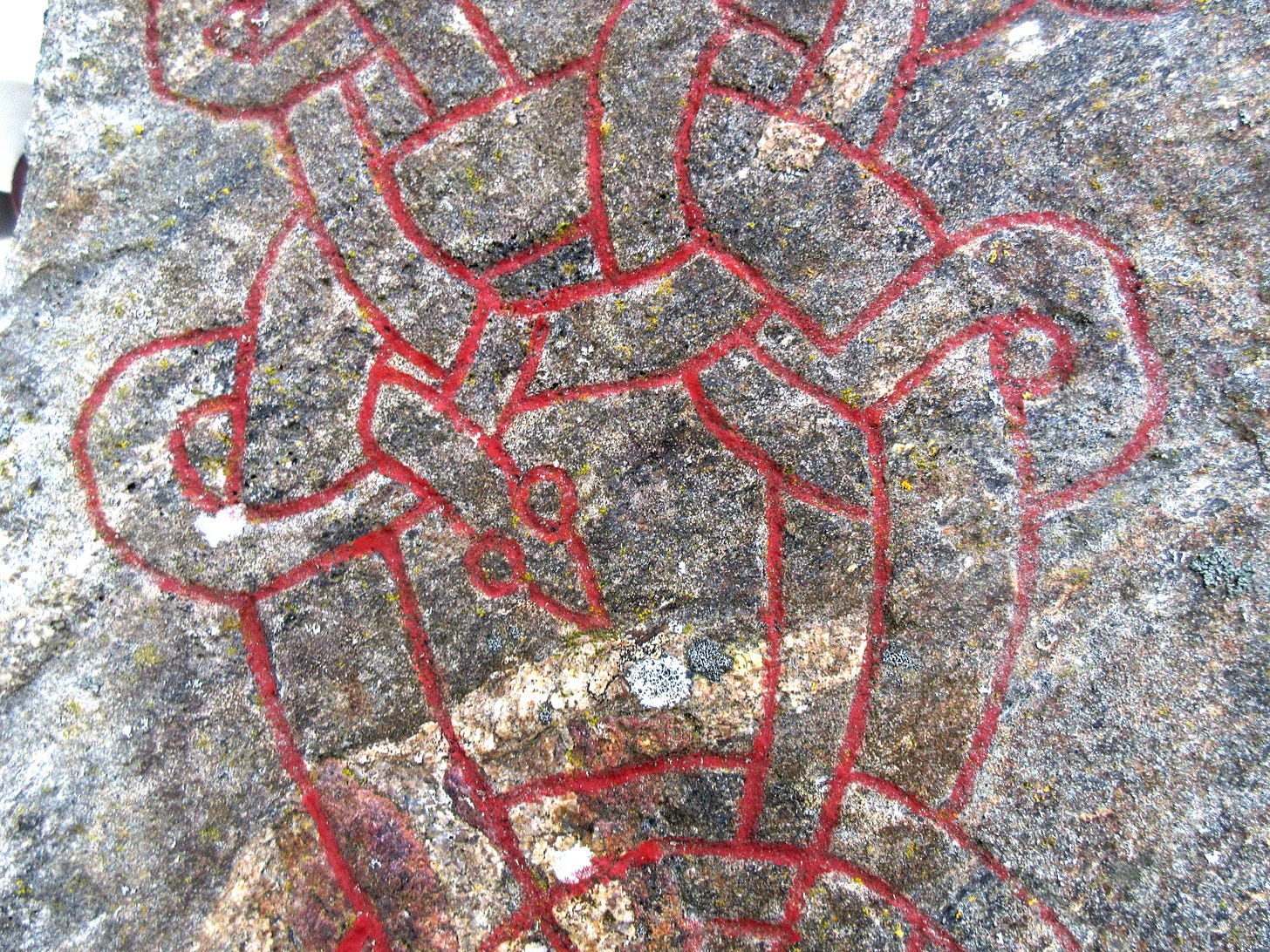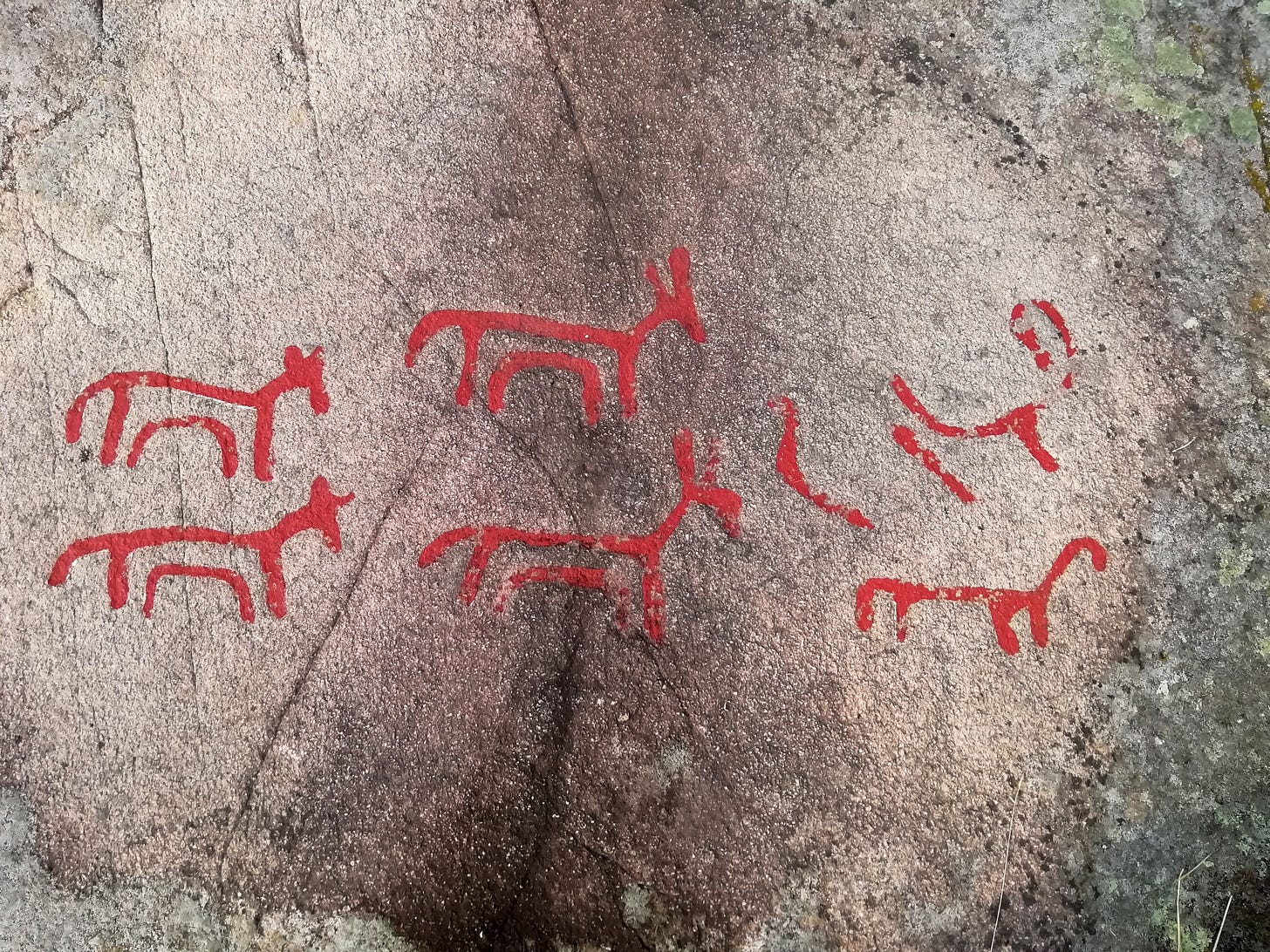Recently my husband and I were out driving here in Sweden, (in the Nynäshamn area south of Stockholm) when a rather alarming destination appeared on Google Maps: Ragnarök! Is this for real?! Who lives there?! We decided to give Ragnarök a miss and keep on driving...
In my series of recent essays we have explored Old Norse and Scandinavian traditions of the Yule or Winter Solstice period. Today we will close this series with an essay about the Swedish tradition of plundering (and discarding) the Christmas tree. We will also unravel a ancient and mysterious knot (before tying it securely again, so the Universe does not fall apart!)
The cultures of Northern pre-Christian Europe viewed the period of Twelve Nights (or Twelve Tide) as a time of danger. The Old Year was dying and there was a time of risk and reversal before the New Year arrived and solidified. In most countries this period ends with Epiphany (Trettondagen Jul in Swedish, literally the thirteenth day of Christmas) but Sweden adds another event to this calendar: Tjugondagen Knut, the 20th day, of the Knot!
EPIPHANY AND LA BEFANA OR THE CHRISTMAS WITCH
The first time I celebrated Christmas in Sweden was in the year 1986. (I was 19 years old and in love!) I was surprised (and charmed) to discover that there is a specific day and ritual for “plundering” and removing the Christmas tree. Traditionally this happens on January 13th, the Day of Knut.
Below is the traditional explanation, courtesy of Nordiska Museet , (the Nordic Museum), in Stockholm:
January 13th arrives exactly 20 days after Christmas and that is what the title of this event means: Tjugondag translates as “Twentieth Day”. The expression is: "På tjugondag Knut körs julen ut!": “On the twentieth day Christmas is driven out!”
Knutdagen, the Day of Knut, is said to derive its name for the Danish duke Knut Lavard (1096 – 1131). He was murdered, just outside Ringstedt in Denmark, on the 7th of January in the year 1131, by his cousin Magnus. Magnus viewed Knut as a rival, well-positioned to rise to power as the successor of King Nils (the father of Magnus). Knut was canonized and declared a saint near the end of the 17th century. The Christmas period was extended by one week and the week of Knut now lasted from the 7th to the 13th of January.
A new (or ancient?) tradition then arrives on the scene. The researcher Olof Rudbeck Senior (1630 – 1702) is the first person to describe a, so called "gästabudskrig" (war on guests or war on hospitality) where the Christmas guests were symbolically driven out of the house, so life could return to normal.
In the 18th century we find the first mention of a related festival, the so called “Julgransplundring” or plundering of the Christmas tree, where it is stripped of all its decorations. Here we need to bear in mind that in times past most of those decorations were homemade and edible (gingerbread people, oranges, candy etc.), not the plastic “rainbow unicorns” we find in the shops today. Today Swedish children still get candy on the day that the tree is thrown out.
As an aside:
Did you know that there is a dedicated day of the week for children to eat candy in Sweden? On Saturdays they demand their “Lördagsgodis” (Saturday sweets) and the shops will advertise their pick-and-mix section accordingly. “REA på Lördagsgodis!” (Saturday Sweets at discounted prices!)
However, this tradition was created in the 1950s to limit the eating of sweets (and by extension reduce plaque and cavities) to only one day a week. My (Swedish) husband had an even better personal strategy for improving dental health: he unfailingly collected his Saturday Sweets but added them to his personal collection without ever actually eating them. Meaning that, over the years, he acquired an impressive mountain of sweets (which his mother chucked out one day, when he was old enough not to be upset about it).
Tjugonday Knut is celebrated only in Sweden, Norway and Finland. In most other countries Christmas is considered well and truly over by then (though I do observe that many people now stretch the Christmas atmosphere in the “other direction” by putting up their Christmas tree some time in November!)
Knut - Knot
I must say that I find the name Knut rather suspicious!
Knut (Norwegian and Swedish), Knud (Danish), or Knútur (Icelandic) is a Scandinavian and German first name, of which the anglicised form is Cnut or Canute... The name is derived from the Old Norse Knútr meaning "knot".
This brings to mind the much older Scandinavian tradition of the “Granny Knot”. I highly recommend the following article by Kirsten Brunsgaard Clausen: The Scandinavian Cailleach – The”Kælling/Kärring”
I found her thought-provoking article when the spirits sent me on a mission (the instructions were to figure out who the Scandinavian counterpart of the Celtic Cailleach is):
“Frost has nipped off the head of all living things. Finally winter! Everything sleeps – from the tiny insect to the big bear. Skeletons of trees stretch out their branches, black and bare. Gray are the heavy clouds, white the frozen ground. Silence. Death … then suddenly – a blood-curdling shriekcuts through the air. Immediately the wind throws back an howling answer. A moment later earth and sky raise a roar together. A tumult of dry leaves and frozen plastic bags whirl round in the storm. People who lose their footing are swept aside. Snowflakes whip in the faces like nails of glass. Now She rules: "the Kælling"! Now is Her time – Her playtime. On the backs of foaming wolves and ragged boars She rides forward 3. She is the Bone-Mother, the age-old Wise One. Wild and playful.”
She explains that the Kärring will reign from “Hel’s Eve” (Hellemisse, All Saints, Samhain) to Disa Dag (Kyndelmisse, Candlemas, the feast day of St Brigit).
In this period she works the miraculous transformation from death to life, from old to new. (Christianity calls it resurrection). This is Death birthing New Life, the most crucial (and most dangerous) part of the greater Cycle of Life.
This role makes Her the most indispensable link in the chain. And to be precise: She is the very lock. She will link old death to new life. When death cuts the thread, Her steady hands will tie the ends together again in a solid knot. And for this operation She will use a Granny Knot, a “Kællinge-knude”! A knot that will never either loosen, nor slide up; a knot impossible to undo when first tightened.
Her final task is done! Now Brigit´s Day is dawning (Candlemas). In Old Danish Candlemas is called ´Kjær-/Kjør-mes Dag (Day) and Kjørmes Knud. A well-known song goes “Candlemas binds its knot hard and with strong determination” (Kyndelmisse slår sin knude, overmåde hvas og hård). “Knud/Knut (Knot) whips out Christmas”, the Danish children used to sing. (Knud, pisker julen ud!)
This brings us right back to Knut Day, of course! Scheduled for January 13th on the Swedish calendar, meaning today! Many places in Sweden had old pagan traditions linked to this day. Children (especially) would dress up in costumes and wear masks. They would go from door to door carrying a male doll made of straw, the Knut’s Gubbe (Old Man Knut or Old Man Knot, depending on how you choose to translate it). The idea is to be invited in for treats and a drink, but stay in role without your real identity being revealed. Dolls of straw, made to resemble old women (the so called Gumma or Crone), were carried around as well and they pose a direct link to the Grandma Goddess tying her cosmic knot.
My advanced Seiðr students and have done work on this. I agree with Brunsgaard Clausen that a much older, pre-Christian festival lurks behind the feast day of a Christian saint (for a much larger collection of examples please read my book North Sea Water In My Veins, about the pre-Christian spirituality of The Low Countries).
If you have not heard of Tjugondag Knut before I invite you to consider celebrating the Day of the (Granny) Knot (or alternatively the Day of Knut) and to honour one of the most ancient goddesses of Old Europe by giving her (back) a place on our calendar!
And if you are skilled in shamanic or magical workings please note that this period of twenty days (more commonly Yuletide is viewed as a window lasting twelve days, a time of risk and reversal) poses a window of opportunity for powerful magical work!
And for those of you eager to dive much deeper into all this: consider attending a Seiðr course or module at my Forest School here in Sweden! There are Bronze Age petroglyphs on my doorstep (see picture below)…
I try (but sometimes fail) to get out at least one essay a week (sometimes several), due to travel, international teaching commitments and family care responsibilities (our family lives with Alzheimer’s and I have written several posts about that). All artwork shown in Substack posts is my own, unless credited differently! If you would like to see regular posts about about Nordic spirituality and my life as a Forest Witch (and of course short videos of all the wildlife here!), please follow me on Instagram or Facebook, thank you!
Imelda Almqvist, Forest House, Sweden
BIO FOR IMELDA ALMQVIST
Imelda Almqvist is an international teacher of Sacred Art and Seiðr/Old Norse Traditions (the ancestral wisdom teachings of Northern Europe). So far she has written four non-fiction books and two picture books for children. Natural Born Shamans: A Spiritual Toolkit for Life (Using shamanism creatively with young people of all ages) in 2016, Sacred Art: A Hollow Bone for Spirit (Where Art Meets Shamanism) in 2019, Medicine of the Imagination - Dwelling in Possibility (an impassioned plea for fearless imagination) in 2020 and North Sea Water In My Veins (The Pre-Christian spirituality of the Low Countries) will be published in June 2022.
The Green Bear is a series of picture book for children, aged 3 – 8 years. The stories and vibrant artwork, set in Scandinavia, invite children to explore enchanting parallel worlds and to keep their sense of magic alive as they grow up.
Imelda has presented her work on both The Shift Network and Sounds True. She appears in a TV program, titled Ice Age Shaman, made for the Smithsonian Museum, in the series Mystic Britain, talking about Mesolithic arctic deer shamanism.
Imelda is currently working on a handbook for rune magicians (about the runes of the Elder Futhark) and on more books in the Green Bear Series. Imelda runs an on-line school called Pregnant Hag Teachings, where all classes she teaches remain available as recordings which can be watched any time!
Website:
http://www.shaman-healer-painter.co.uk/
YouTube Channel: youtube.com/user/imeldaalmqvist
Online School: https://pregnant-hag-teachings.teachable.com/courses/
Facebook: https://www.facebook.com/imelda.almqvist/
Instagram: https://www.instagram.com/almqvistimelda/









Thank you! This Scottish ballad speaks of the carlin wife and her attempt to bring her sons back from the dead.
The Wife of Usher’s Well
There lived a wife at Usher’s Well,
And a wealthy wife was she;
She had three stout and stalwart sons,
And sent them oer the sea.
They hadna been a week from her,
A week but barely ane,
Whan word came to the carline wife
That her three sons were gane.
They hadna been a week from her,
A week but barely three,
Whan word came to the carlin wife
That her sons she’d never see.
‘I wish the wind may never cease,
Nor fashes in the flood,
Till my three sons come hame to me,
In earthly flesh and blood.’
It fell about the Martinmas,
When nights are lang and mirk.
The carline wife’s three sons came hame,
And their hats were o’ the birk.
It neither grew in syke nor ditch,
Nor yet in ony sheugh;
But at the gates o’ Paradise,
That birk grew fair eneugh.
‘Blow up the fire, my maidens,
Bring water from the well;
For a’ my house shall feast this night,
Since my three sons are well.’
And she has made to them a bed,
She’s made it large and wide;
And she’s ta’en her mantle her about,
Sat down at the bed-side.
Up then crew the red, red cock,
And up and crew the gray
The eldest to the youngest said,
‘Tis time we were away.’
The cock he hadna craw’d but once,
And clapp’d his wings at a’,
When the youngest to the eldest said,
‘Brother, we must awa’.
‘The cock doth craw, the day doth daw,
The channerin’ worm doth chide;
Gin we be miss’d out o’ our place,
A sair pain we maun bide.’
‘Lie still, lie still but a little wee while,
Lie still but if we may;
Gin my mother should miss us when she wakes,
She’ll go mad ere it be day.’
‘Fare ye weel, my mother dear!
Fareweel to barn and byre!
And fare ye weel, the bonny lass
That kindles my mother’s fire!’
This ancient ballad, shaped over centuries by the keen tongues and inventive memories of “Anon”, appeared in print for the first time in 1802, in Walter Scott’s Minstrelsy of the Scottish Border. Scott’s incomplete version was recited to him by an old woman living in Kirkhill, West Lothian. Also collected by Francis James Child, the ballad became particularly popular in America. There are many variants. The expanded version I’ve picked is online here.
The first stanza briskly sets the scene. Our suspense, now sharpened, builds in the time-span of one to three weeks noted in the second line refrains of stanzas two and three. The Wife’s three sea-going sons are “gane” (but just conceivably might have survived the shipwreck) in stanza two, but the worst is confirmed in three, “Whan word came to the carline wife / That her sons she’d never see.”
The term “carline” can apparently allude to both “old woman” and “witch” – concepts once thought naturally interchangeable. Stanza four may echo a mother’s cry of grief, or a witch’s spell: it’s possibly both. The wish centres on images of relentless wind and “troubles” (fashes) “in the flood” – eternal shipwrecking weather until the drowned sons “ come hame to me / In earthly flesh and blood”. It’s a terrific stanza, true to the psychology of intense grief, in which lamentations for the unjustly dead may be intertwined with vengeful anger against the living.
Martinmas, a festive occasion, falls on 11 November. It’s time for the ghostly visitation. The night is “lang and mirk” … and all we initially see of the visitors are the three hats hanging on the birch tree. Anon is plainly a poet of Imagist potential …
More mysteriously still, the tree itself seems a kind of haunting. It grows in no earthly “syke” (marsh, small stream), ditch or trench, but only at the “gate o’ paradise” – so why is it here at Usher’s Well? Have the wife and her retinue been “ushered” into some outpost of paradise? Perhaps the entire worlds of death and life have somehow fused – a pleasantly spine-chilling thought. Meanwhile, the maids set the fire blazing, water is fetched, the feast prepared. The narrator doesn’t show us any direct inter-action between the sons and their mother. The mother simply rejoices that they are “well”. And by the next verse, the feast is already over: the mother has wrapped herself in her mantle to sit by the boys’ carefully-made bed, as if finally keeping the death vigil denied her.
Dawn cock-crow, as is traditional, warns the ghosts to hurry to their graves. That there are two cocks, one red, one grey, might be another suggestion that two states, red-blooded life and shadowy death, are working in counterpoint. The story is suddenly enlivened by eldest and youngest sons’ voices. The differing pronunciation of “away” and “awa” adds a little characterisation.
Touchingly, in the current version, the sons decide not to move before the mother wakes, because of the distress their sudden disappearance would cause her. That stanza is omitted from Scott’s version, leaving us simply with the sons’ collective expression of regret – a regret for appetite and sexual vigour, nearly restored, and now again to be lost.
This tragi-comic ghost story still maintains its appeal. It demonstrates the power of love (aided or not by witchcraft) to call up the dead in defiance of logic and those channerin’ (fretting) worms. Time-marking repetitions in the narrative (“They hadna been a week from her”, “The cock he hadna crawd but once”) are the conventional rhythmic tropes of balladry, but they recognisably sound the pulse of all life-stories – the rituals and reassurances, hopes and losses, and the rapid drum-beat of time, time, time.
I was surprised to reach the description of the Granny Knot as holding fast! When I learned how to tie a square knot—a knot that holds fast—I learned that tying it the wrong way resulted in a weak “granny knot.” Now I wonder if the meaning was changed on purpose at some point, in an attempt to weaken the old ways!